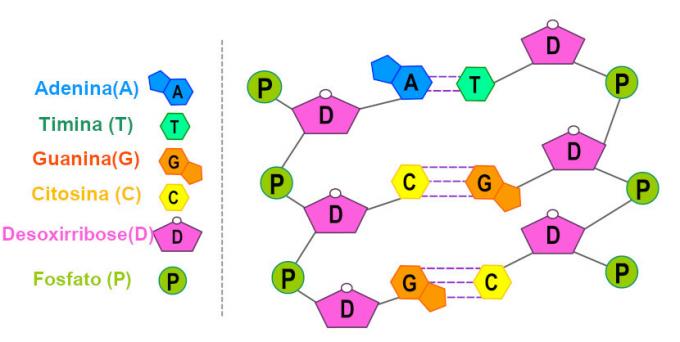nucleotide is the subunit that forms DNA and RNA, nucleic acids related to heredity and control of the activity of cells. A nucleotide is made up of a phosphate group, a nitrogenous base, and a pentose. DNA and RNA differ as to the pentose they have and also as to the nitrogenous bases.
Read too: Genes - what's yours? importance nothe determination of the characteristics of living beings?
Nucleotide Summary
- Nucleotide is the subunit that forms nucleic acids.
- There are two types of nucleic acids: DNA and RNA.
- A nucleotide is made up of a phosphate group, a nitrogenous base, and a pentose.
- DNA and RNA differ in terms of the sugar present in their structure and also in terms of the nitrogenous base.
- The pentose of DNA is deoxyribose, while the pentose of RNA is ribose.
- Adenine, guanine and cytosine are observed in both DNA and RNA.
- Thymine is observed only in DNA.
- Uracil is only observed in RNA.
Nucleotide video lesson
Nucleotide composition
Nucleic acids are formed by joining together smaller molecules called nucleotides. Nucleotides are generally made up of three parts:

- A five-carbon sugar (pentose): The pentoses found in nucleic acids are ribose (C5H10THE5) and deoxyribose (C5H10THE4).
- A nitrogenous base: Nitrogen bases can be of two types: pyrimidines and purines. A pyrimidine has a ring of six atoms, whereas purines have a six-atom ring fused to a five-atom ring. The purines are: adenine (A) and guanine (G). The pyrimidines are: cytosine (C), thymine (T) and uracil (U)
- A phosphate group: The phosphate group originates from the acid phosphoric.

Nucleotides are joined together to form polynucleotides. Adjacent nucleotides form a bond between the phosphate group of one nucleotide and the pentose group of the next nucleotide. This bond is responsible for forming the sugar-phosphate backbone.
Also access: Chromosomes — structures made up of DNA and proteins
DNA and RNA: Nucleic Acids Made of Nucleotide
DNA (deoxyribonucleic acid) and RNA (ribonucleic acid) are two types of nucleic acids that are related to the control of cellular activity and heredity, that is, with the transmission of the characteristics of living beings between generations. DNA and RNA differ in terms of the sugar present in their structure and also in terms of the nitrogenous base.
As for sugar:
- in DNA, there is the sugar called deoxyribose (hence the name deoxyribonucleic acid);
- in RNA, the sugar is a ribose (hence the name ribonucleic acid).
The difference between these two types of sugar is that deoxyribose has one less oxygen atom attached to the second carbon atom of the ring.
Regarding nitrogenous bases:
- in DNA, there are only nucleotides that have the bases adenine, guanine, cytosine, and thymine.
- in RNA, there are only nucleotides that have the bases adenine, guanine, cytosine, and uracil.
We can conclude, therefore, that adenine, guanine and cytosine are observed in both DNA and RNA, whereas the thymine is found only in DNA, and uracil only in RNA.

DNA structure
DNA molecules have two polynucleotides that are coiled together, forming the structure known as double helix. The outer part of the helix is formed by the sugar-phosphate backbones, while the nitrogenous bases are paired inside the helix. The two polynucleotides are joined by bonds established between the base pairs.
The union between the base pairs does not occur randomly, so the pairing is observed only with compatible bases. Adenine present in one chain, for example, pairs only with thymine in another chain. Guanine, on the other hand, pairs only with cytosine. This means that if we read the base sequence of one chain, we will immediately know which bases form the other chain. To learn more, visit: DNA.
RNA structure
The molecules of RNA, unlike DNA molecules, are not in a double helix. RNA occurs in single chain.Base pairing can occur in RNA, leading to the formation of three-dimensional structures. Transfer RNA, for example, has a shape resembling an L, and pairing is observed in some regions. In RNA, the adenine pairs with uracil, since thymine is not present.
It is worth noting that during the transcription process (RNA production), the two strands of the DNA molecule separate. at certain points, and the bases of the RNA nucleotides pair with their complements present in the RNA chain. DNA. The nucleotides join together, causing the synthesis of the RNA molecule, which is detached from the DNA molecule. The link between the two strands of DNA is then re-established.
Video lesson on RNA transcription
Solved exercises on nucleotide
question 1
DNA base pairing occurs only between compatible bases. When we know the sequence of bases of one chain, we can identify which sequence of bases is present in the other. Therefore, if a chain has the sequence AGCT, the complementary chain has the sequence:
A) TCGA
B) AAGC
C) AGCT
D) TUGA
E) UCGT
Resolution:
Alternative A
Adenine only pairs with thymine, and guanine only pairs with cytosine.
question 2
(Unicentro) According to the DNA model proposed by James Watson and Francis Crick, the molecule is formed by two long chains arranged in the form of a double helix. A given chain has a sequence of nucleotides formed by a phosphate group, a deoxyribose and a nitrogenous base that can be of four types:
A) Adenine (A), uracil (U), cytosine (C) and guanine (G).
B) Adenine (A), uracil (U), phenylalanine (FA) and thymine (T).
C) Adenine (A), alanine (Al), cytosine (C) and thymine (T).
D) Guanine (G), uracil (U), cytosine (C) and thymine (T).
E) Adenine (A), thymine (T), cytosine (C) and guanine (G).
Resolution:
Alternative E
Uracil is a nitrogenous base present only in RNA. Alanine and phenylalanine are amino acids. Thus, the alternative that represents nitrogenous bases present in DNA is the letter E.


